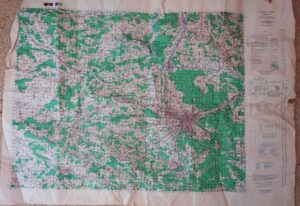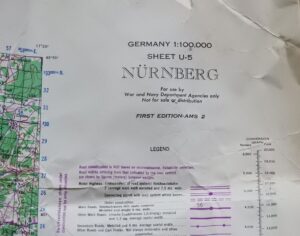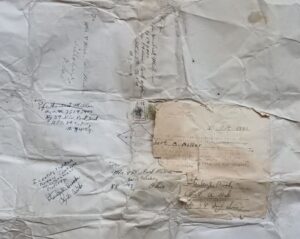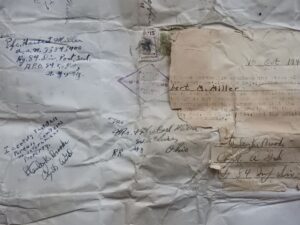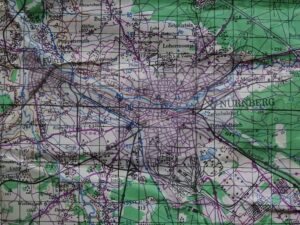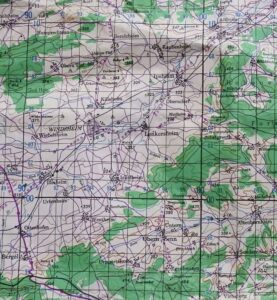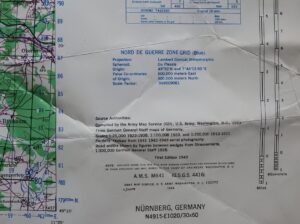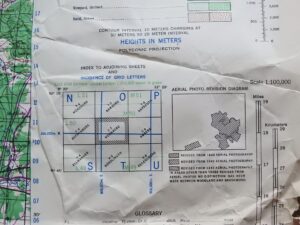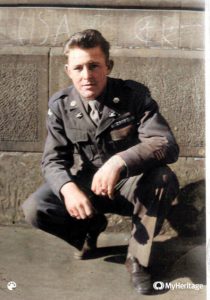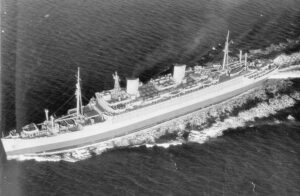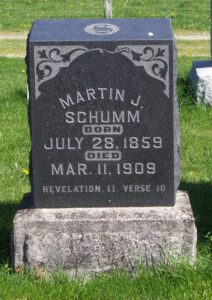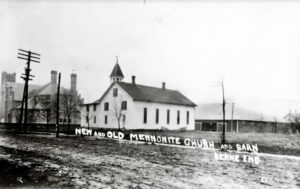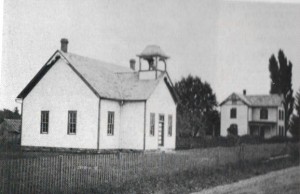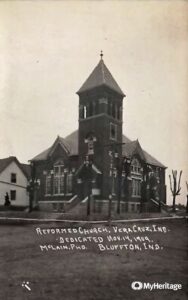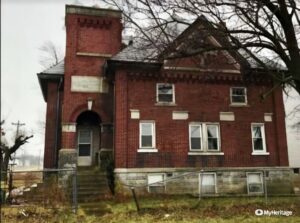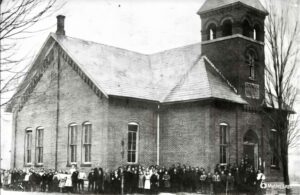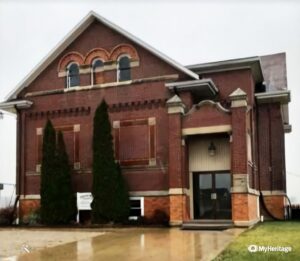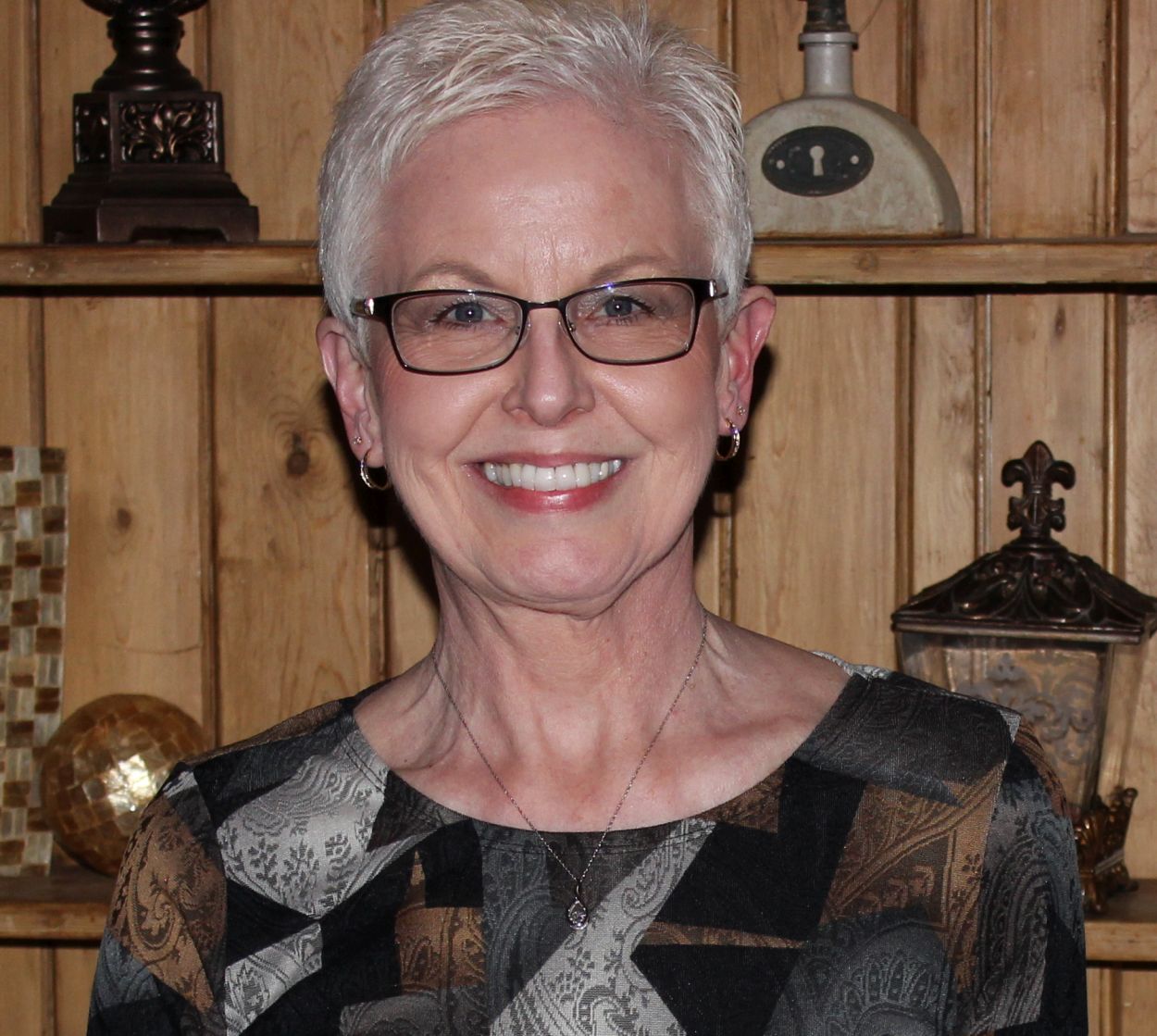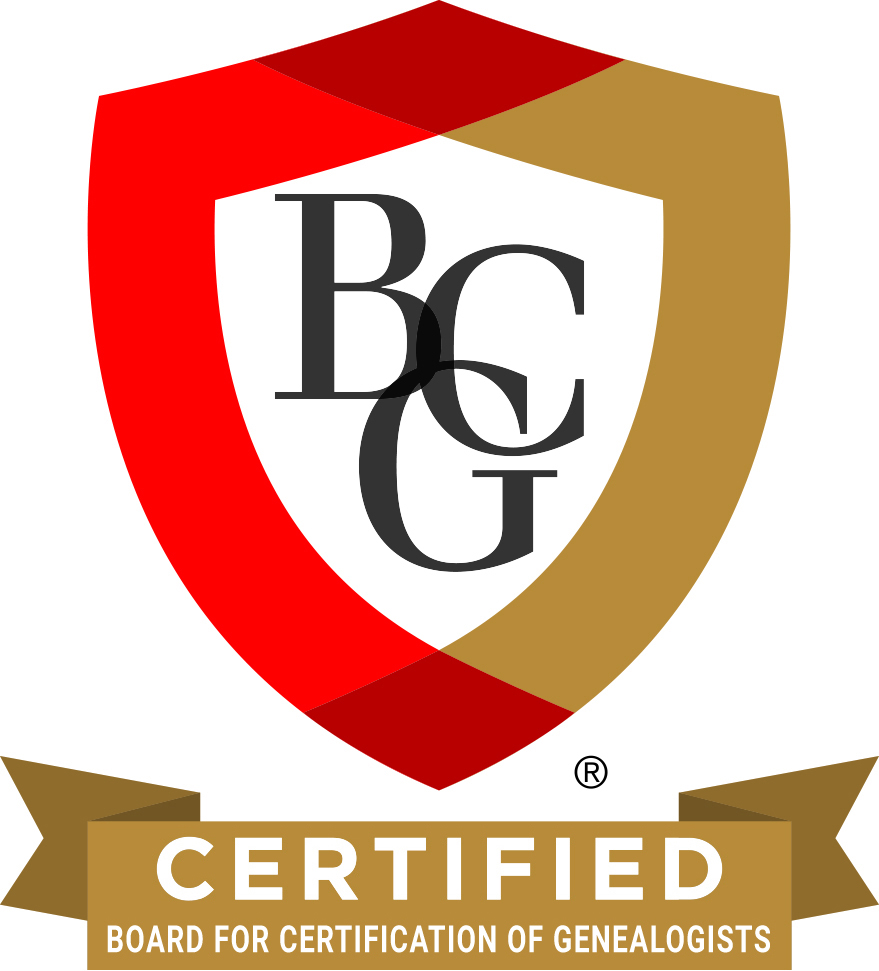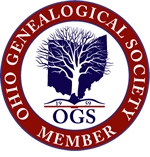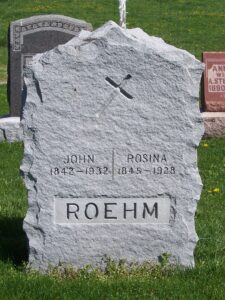
John & Rosina (Schumm) Roehm, Zion Lutheran Cemetery, Van Wert County, Ohio. (2012 photo by Karen)
This is the tombstone of John and Rosina (Schumm) Roehm, located in row 10 of Zion Lutheran Cemetery, Schumm, Van Wert County, Ohio. The marker is inscribed:
John
1842-1932
Rosina
1845-1928
ROEHM
John Roehm was born in Dixon, Ohio, on 22 December 1842, the son of Andrew (1814-1902) and Anna “Katharine” (Bienz) (1819-1858) Roehm. John’s parents were both German immigrants. [1]
The Andrew Roehm family in 1850, when John was 7 years old: Andrew Roehm, 37; Catharine, 31; Mary, 9; John, 7; Elizabeth, 5; Jacob, 3; and Christian, 1. Andrew was a farmer. [2]
John Roehm’s mother Katherine (Bienz) died in 1858. His father married Friedericke Gutheil in November 1860 and they had three children.
The Andrew Roehm family in 1860: Andrew Roehm, 45; Mary, 18; John, 16; Elizabeth, 14; Jacob, 13; Christina, 11; Henry, 9; Emanuel, 7; and Anna, 3. [3]
John Roehm married Rosina Schumm at Zion Schumm on 10 April 1870.
Anna “Rosina” Schumm was born 1 January 1845, likely in Van Wert County, Ohio, the daughter of George Martin (1812-1871) and Maria (Pflueger) (1820-1903) Schumm. Her baptism is not recorded in Zion Schumm’s records. Both of her parents were German immigrants.
The George Martin Schumm family in 1850, when Rosina was 5 years old: George Schumm, 38; Mary, 30; Fred, 11; Louis, 9; George, 8; John, 6; Rosina, 5; Margaret, 2; Mary, 1; Elisabeth Pflueger, 14; Jacob Bienz, 24. [4] Elizabeth Pflueger was Rosina’s aunt, her mother Mary’s sister. Jacob Bienz was a brother to Katherine (Bienz) Roehm, wife of Andrew Roehm. Elizabeth Pflueger married Jacob Bienz in 1851.
The George Martin Schumm family in 1860, when Rosina was 15 years old: George, 47; Mary, 46; Frederick, 21; Louis, 19; George, 18; John, 17; Rosina, 15; Mary, 11; Jacob, 9; Christian, 7; Henry, 5; and Martin, 4 months. [5]
After their April 1870 marriage John and Rosina Roehm lived with Martin and Mary (Schumm) Schinnerer. Rosina and Mary were first cousins. Their mothers were sisters.
The John Roehm family in 1870: John Roehm, 27; Anna R, 25; Martin Schinnerer, 63, [36] male, born in Bavaria; Mary Schinnerer, 27; Frederick Schinnerer, 9; Henry Schinnerer, 7; John Schinnerer, 5; and Barbara Schinnerer, 3. John Roehm was a farmer. [6] Frederick Schinnerer, age 9 in this enumeration, would eventually marry John and Rosina Roehm’s daughter Minnie, who was born in 1871.
The John Roehm family in 1880: John, 37; Rosina, 34; Minnie, 8; Andrew, 6; Julia, 5; Pauline, 4; and Mary H, 2. [7]
The John Roehm family in 1900: John 57; Rosina, 55; Fred, 27; Louis J, 18; Albert C, 16; Alma, 16. The couple had been married 30 years and had 8 children, 7 of whom were living at that time. They had a pair of twins, Albert and Alma, born in 1883. [8]
The John Roehm family moved to Fort Wayne, Indiana, by 1910, living at 2430 Hanna Street: John, 66; Rosina, 64; Alma S, 26; and Albert C, 26. No occupation was given for the father John, but Albert worked as a machine hand for a steam railroad. Alma worked in a jewelry shop. [9]
The John Roehm family in 1920, still residing at 2430 Hanna Street in Fort Wayne: John, 77; Rosa, 75; and Alma, 36. John was retired and Alma had no occupation. [10]
Rosina (Schumm) Roehm, died in Willshire Township, on 22 May 1928 of mitral valve regurgitation. She was 83 years, 4 months, and 21 days old. Her usual residence was Fort Wayne but she had been living in Van Wert for 1 month. She was married to John Roehm and was a retired housewife. She was buried on the 24th. [11]
In 1930 widower John Roehm lived with his daughter Alma and husband Herman Kraft, at 2208 Oliver Street in Fort Wayne. Their household: Herman Kraft, 51; Alma Kraft, 46; and John Roehm, 87, widower. Herman Kraft was a molder in a foundry. [12]
John Roehm died from pneumonia in Willshire Township on 31 August 1932, at the age of 89 years, 8 months, and 9 days. His death/burial is not recorded in Zion Schumm’s records, but according to his death certificate he was born in Dixon, Van Wert County, Ohio, to Andrew Roehm and Anna Bienz, was married to Rosina Roehm, but was widowed. He was a retired farmer and was buried on 2 September. [1]
John Roehm’s obituary:
John Roehm of Fort Wayne, died yesterday at the home of his daughter, Mrs. Fred Schinnerer, in Willshire, after an illness of about two years. Mr. Roehm was aged about ninety years and removed to Fort Wayne from Willshire in 1906. He was a member of the Zion Lutheran Church and was a retired farmer. Among his direct survivors are four daughters, Mrs. William Franke, of Pittsburgh, Mrs. Fred Acker, and Mrs. Herman Kraft, of Fort Wayne, and Mrs. Fred Schinnerer, of Willshire, two sons, Rev. Louis J. Roehm, of Hudson, New York, and Albert Roehm, of Carnegie, Pennsylvania, one brother, Henry Roehm, of Long Lake and two sisters, Mrs. Henry Reidenbacher [sic], of Schumm, Willshire township, and Mrs. Joseph Coon, of Celina. A brief funeral service will be held Friday afternoon, at 1:30 o’clock, at the Lutheran Church, at Schumm. Interment will be made in the church cemetery. [13]
John and Rosina (Schumm) Roehm had the following children:
Maria Wilhelmina Amalia “Minnie” (1871-1953), married George “Frederick” Schinnerer
Andreas “Friedrich” George (1872-1926), married Henrietta Amalia Schumm
Mary “Julia” (1875-1957), married William Conrad Franke
Charlotte “Paulina” (1876-1962), married Frederick J. Acker
Marie Therese (1878-1892)
John “Louis” (Rev.) (1881-1975), married Anna Elizabeth Peters
Albert Christian (1883-1953)
Alma Sophie (1883-1974), married Herman Kraft
[1] “Ohio Deaths, 1908-1953,” Willshire, Van Wert, Ohio, John Roehm, 31 Aug 1932; database with images, FamilySearch.org (https://www.familysearch.org/ark:/61903/3:1:33SQ-GPRW-SWCB?i=135&cc=1307272&personaUrl=%2Fark%3A%2F61903%2F1%3A1%3AX6SP-PM9 : viewed 23 Aug 2020).
[2] 1850 U.S. Census, Tully, Van Wert, Ohio, p.189A, dwelling 406, family 425, Andrew Reem; digital image by subscription, Ancestry.com (https://www.ancestry.com/search/collections/8054/ : viewed 23 Aug 2020).
[3] 1860 U.S. Census, Willshire, Van Wert, Ohio, p.427, dwelling 1099, family 1093, Andrew Rackin; digital image by subscription, Ancestry.com (https://www.ancestry.com/search419 /collections/7667/ : viewed 23 Aug 2020).
[4] 1850 U.S. Census, Willshire, Van Wert, Ohio, p.166B, dwelling 114, family 131, George Shuman; digital image by subscription, Ancestry.com (https://www.ancestry.com/search/collections/8054/ : viewed 23 Aug 2020).
[5] 1860 U.S. Census, Willshire, Van Wert, Ohio, p.425, dwelling 1068, family 1062, George Schanen; digital image by subscription, Ancestry.com (https://www.ancestry.com/search419 /collections/7667/ : viewed 2 Aug 2020).
[6] 1870 U.S. Census, Willshire, Van Wert, Ohio, p.432B, dwelling 86, family 87, John Rochin/Roehm; digital image by subscription, Ancestry.com (https://www.ancestry.com/search/collections/7163/ : viewed 23 Aug 2020).
[7] 1880 U.S. Census, Willshire, Van Wert, Ohio, ED 154, p.449B, family 123, John Roehm; digital image by subscription, Ancestry.com (https://www.ancestry.com/search/collections/6742/ : viewed 23 Aug 2020).
[8] 1900 U.S. Census, Willshire, Van Wert, Ohio, ED 97, p.8, dwelling 165, family 178, John Roehn; digital image by subscription, Ancestry.com (https://www.ancestry.com/search/collections/7602/ : viewed 23 Aug 2020).
[9] 1910 U.S. Census, Fort Wayne Ward 7, Allen, Indiana, ED 554, p.16B, dwelling 360, family 366, John Roehm; digital image by subscription, Ancestry.com (https://www.ancestry.com/search/collections/7884/ : viewed 23 Aug 2020).
[10] 1920 U.S. Census, Fort Wayne Ward 7, Allen, Indiana, ED 65, p.21A, dwelling 455, family 466, John Roehm; digital image by subscription, Ancestry.com (https://www.ancestry.com/search/collections/6061/ : viewed 23 Aug 2020).
[11] “Ohio Deaths, 1908-1953,” Willshire Twp, Van Wert, Ohio, Rosina Ann Roehm, 22 May 1928; database with images, FamilySearch.org (https://www.familysearch.org/ark:/61903/3:1:33SQ-GPK4-STS8?i=2741&cc=1307272&personaUrl=%2Fark%3A%2F61903%2F1%3A1%3AX8G3-4Q6 : viewed 23 Aug 2020).
[12] 1930 U.S. Census, Fort Wayne, Allen, Indiana, ED 42, p.22A, dwelling 464, family 496, Herman Kraft; digital image by subscription, Ancestry.com (https://www.ancestry.com/search/collections/6224/ : viewed 23 Aug 2020).
[13] Van Wert Daily Bulletin, Van Wert, Ohio, p.3, 1 Sep 1932, digital images by subscription, Ancestry.com, viewed 23 Aug 2020.

